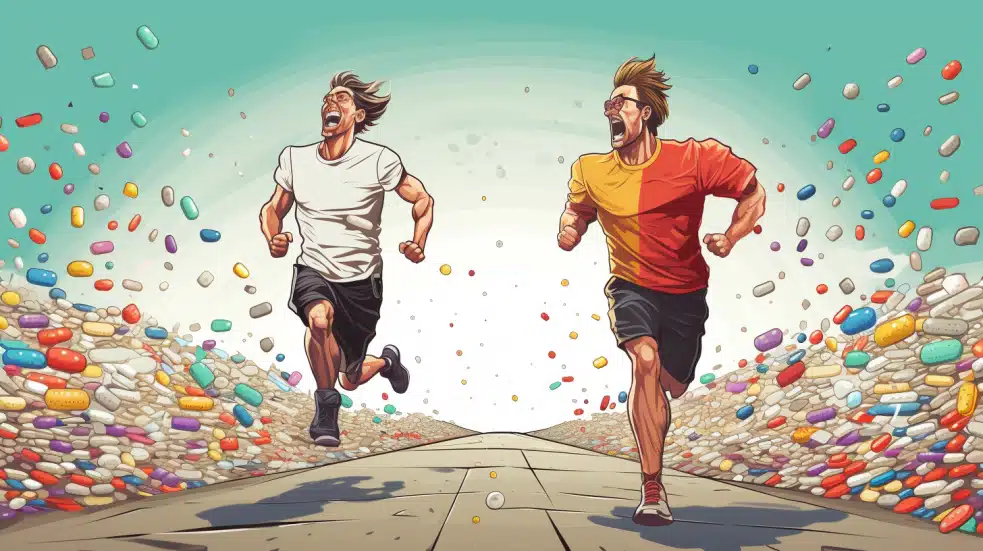New research finds that regular running is just as effective as antidepressants for treating depression and anxiety, and leads to better physical health outcomes.
Key Facts:
- In a study of 141 patients, running therapy and antidepressant medication had comparable effects on rates of remission (no longer meeting diagnostic criteria) from depression/anxiety disorders.
- However, running led to more favorable changes than antidepressants across several indicators of physical health like weight, blood pressure, heart rate variability, etc. Antidepressants were actually associated with worsening of some physical health markers.
- This highlights running as an excellent first-line treatment option for mental health issues, with physical health benefits. Antidepressants may be unsuitable for persons with physical health problems.
Source: J Affect Disord. (2023)
The Mental Health Crisis and Need for Holistic Treatments
The world is in the midst of a mental health crisis. In the US alone, over 50 million adults deal with mental illness every year.
Depression and anxiety disorders are amongst the most common issues, together affecting around 1 in 5 individuals at some point in their lifetime.
The personal suffering imposed by these conditions is immense, severely compromising quality of life.
Economically too, the estimated costs are over $210 billion per year in the US when considering healthcare utilization, disability and lost work productivity.
Access to prompt, effective mental health interventions is therefore an urgent public health priority. However, the unfortunate reality is that a majority of patients remain untreated or undertreated. Reasons include social stigma around mental illness, treatment costs and availability issues.
Mainstay treatments for depression and anxiety recommended in clinical guidelines include psychotherapy and antidepressant medications.
But response rates are moderate at best, with only about 50% of patients showing substantial improvement.
Plus, antidepressants often have troublesome side effects leading many to discontinue usage.
So there is a pressing need for alternative evidence-based treatment options that are accessible, affordable, tolerable and able to produce satisfactory outcomes on both psychological well-being and physical health.
One intervention garnering attention in this regard is exercise therapy, specifically running/jogging.
Physical Exercise for Mental Health
Intuitively it makes sense that staying active through exercise might help alleviate distressing emotions and worried thoughts.
Physical activity releases endorphins – chemicals that elevate mood and induce pleasant feelings.
Social stimulation and sense of achievement from exercising could also manifest into mental health gains.
Indeed, studies confirm exercise positively impacts mental health, reducing symptoms of both depression and anxiety disorders.
Comparative trials indicate similar effectiveness to gold standard treatments like cognitive behavioral therapy (talk therapy) and antidepressant medications.
Effects are strongest for regular moderate-to-vigorous intensity aerobic exercise – like running.
Just a few sessions per week for 10-16 weeks can make a significant difference.
But an open question is how exercise might compare with pharmacological antidepressants specifically, on both psychological and physical health parameters.
This issue takes on greater prominence knowing antidepressants can adversely affect physiological functioning (see below).
New Study Compares Running Therapy With Antidepressants

A newly published study in the Journal of Affective Disorders specifically investigated effects of a 16-week running program compared to antidepressant medication in 141 depressed and anxious patients.
This research was conducted by an interdisciplinary team spanning fields of psychiatry, physiology and sports science at the Amsterdam University Medical Center, Netherlands.
The randomized trial recruited patients aged 18-70 years meeting diagnostic criteria for major depression or one or more common anxiety disorders – generalized anxiety, social anxiety, panic or agoraphobia.
Patients had the choice to be randomly allocated to either (1) running therapy or (2) antidepressant medication groups.
Those declining randomization selected their preferred treatment.
This “partially randomized preference design” helped ensure acceptability and hence ecological validity.
Ultimately 45 participants took antidepressants – escitalopram or sertraline.
And 96 underwent thrice-weekly group jogging sessions of 30-45 minutes continuous running at moderate-to-vigorous intensity, under supervision by coaches monitoring progress.
Mental and physical health assessments occurred before and after the 16-week intervention period.
Psychological evaluations tested for diagnostic remission (no longer meeting criteria for depressive/anxiety disorder) and whether self-reported symptom severity reduced by 50% or greater (deemed “response” to treatment).
Physical health markers encompassed metabolic indices (like cholesterol, blood sugar), inflammation, heart rate variability, cardiovascular fitness, lung capacity, strength, weight and body composition (abdominal obesity).
Running Matches Antidepressant Efficacy for Depression & Anxiety
In terms of mental health impacts, the researchers found running was just as effective as antidepressants overall.
Rates of achieving remission – no longer qualifying for a clinical diagnosis – were statistically equivalent at approximately 44% in both groups.
Similarly, response rates signifying meaningful abatement of symptoms stood at 30-47%, with no significant differences based on treatment type.
Looking at week-to-week symptom trajectories over the 16 weeks, severity of both depression and anxiety diminished progressively.
Again no statistically noticeable divergences emerged between medication and exercise groups – though anxiety levels dropped quicker initially with medications.
Altogether these findings reinforce running/aerobic exercise as a feasible first-line treatment choice for mild-moderate mental illness, similar to antidepressants in efficacy.
Given swimming, dancing, cycling etc. would likely yield comparable mental health benefits, physicians could prescribe “running therapy” more broadly as “aerobic exercise therapy” too.
Running Trumps Medication for Boosting Physical Health
Now, while the two interventions matched up well for alleviating depression/anxiety, salient differences emerged regarding impacts on physical health and physiological functioning.
Here running therapy uniformly outperformed antidepressants – by eliciting more favorable changes overall.
Alternatively, detrimental effects manifest with several medication-linked markers.
Starting with body composition, the exercise group showed a mean 1-2 cm reduction in abdominal fat (waist circumference) over 16 weeks.
Those using antidepressants instead averaged weight gain of 3 kg and waist increase of 1.5 cm.
These suggest medications heighten obesity risk – an already concerning issue among psychiatric populations.
Heart health impacts also diverged notably.
While running therapy participants’ heart rate dropped by 3 beats-per-minute indicating enhanced cardiovascular fitness, their heart rate variability (HRV) went up.
Higher HRV implies greater cardiac adaptability and resilience.
Conversely, the antidepressant cohort displayed no heart rate change but by week 16 their HRV declined by a worrying 15 milliseconds.
Compromised HRV predicts higher cardiovascular disease incidence including heart attacks.
Blood pressure changes told a similar story.
Runners recorded average systolic and diastolic blood pressure drops of 2-3points by week 16 (in the healthy direction), versus climbs of 4 and 2 points respectively among medicated patients – denoting worsening pressures.
Once more, this pattern forecasts amplified cardiovascular risk from long-term antidepressant usage.
Beyond fitness and heart indices, running still outperformed antidepressants though differences on other physical markers like inflammation, cholesterol etc. were statistically insignificant.
But collating outcomes across all parameters, running dominated over medications in yielding broad-based physiological improvements – cutting cardiovascular risk, boosting fitness, potentially slowing metabolic disease progression.
Whereas several concerning medication-linked changes materialized over just 16 weeks.
Running Should Be First-Line for Depression/Anxiety Treatment
This investigation provides compelling evidence favoring aerobic exercise, specifically running, over antidepressant pills as the foremost treatment option for common mental health disorders like depression and anxiety.
For psychological symptoms the two are matched evenly – both easing distress and returning ~40-50% of patients to mental wellness/remission within 4 months.
However for physical health, consistent gains emerge from running while medications frequently incur adverse effects increasing future disease risks.
Therefore running therapy should be strongly recommended as a first-line treatment strategy in clinical practice guidelines and policies targeting depression/anxiety.
Counseling patients towards exercise aligns perfectly with broader public health goals promoting active lifestyles and combating noncommunicable disease epidemics worldwide.
Still, some patients due to severity of illness or lack of social support may be unable to readily initiate or sustain regular aerobic activity without medical back-up.
Here collaborative approaches blending medications initially alongside gradually intensifying physical activity, may offer the safest passage.
But the end goal should be tapering drugs until exercise by itself preserves mental health.
Encouragingly, in today’s digital fitness landscape with smartwatches and apps galore, adopting and adhering to routine workouts has become easier than ever.
Telemedicine also expanding access to specialist coaching/support.
Although costs can still deter engagement given exercise is rarely covered by insurance, unlike physician services and medications.
Thankfully most people can exercise outside for free… running mostly just requires good running shoes and a path.
References
- Study: Antidepressants or running therapy: Comparing effects on metnal and physical health in patients with depression and anxiety disorders
- Authors: Verhoeven et al. (2023)







